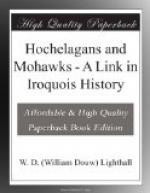at first called, and soon, through the genius of the
Mohawk Hiawatha, they formed with them the famous
League, in the face of the common enemy. By that
time the Oneidas had become separated from the Mohawks.
These indications place the date of the League very
near 1600. The studies of Dr. Kellogg of Plattsburgh
on the New York side of Lake Champlain and of others
on the Vermont shore, who have discovered several
Mohawk sites on that side of the lake may be expected
to supply a link of much interest on the whole question,
from the comparison of pottery and pipes. On
the whole the Hochelagan facts throw much light both
forward on the history of the Iroquois and backwards
on that of the Huron stock. Interpreted as above,
they afford a meagre but connected story through a
period hitherto lost in darkness, and perhaps a ray
by which further links may still be discovered through
continued archaeological investigation.
NOTE. Like the numbers of the Hochelagan race, the question how long they had been in the St. Lawrence valley must be problematical. Sir William Dawson describes the site of Hochelaga as indicating a residence of several generations. Their own statements regarding the Huron country—that they “had never been there”, and that they gathered their knowledge of it from the Ottawa Algonquins, permits some deductions. If the Hochelagans—including their old men—had never been westward among their kindred, it is plain that the migration must have taken place more than the period of an old man’s life previous—that is to say more than say eighty years. If to this we add that the old men appear not even to have derived such knowledge as they possessed from their parents but from strangers, then the average full life of aged parents should be added, or say sixty years more, making a total of at least one hundred and forty years since the immigration. Something might, it is true, be allowed for a sojourn at intermediate points: and the scantiness of the remarks is also to be remembered. But there remains to account for the considerable population which had grown up in the land from apparently one centre. If the original intruders were four hundred, for example, then in doubling every twenty years, they would number 12,800 in a century. But this rate is higher than their state of “Middle-Barbarism” is likely to have permitted and a hundred and fifty years would seem to be as fast as they could be expected to attain the population they possessed in Cartier’s time.
FOOTNOTES:
[1] “Iroquois Book of Rites,” p. 10.
[2] Ibid., p. 13.
[3] The latter I conjecture not to be the real name of the place but that the Stadacona people had referred to Hochelay as “Agojuda” or wicked. The chief of Hochelay on one occasion warned Cartier of plots at Stadacona, and there appears to have been some antagonism between the places. The Hochelay people seem to have been Hochelagans proper not Stadacona Hochelagans. Hochelay-aga could mean “people of Hochelay.”




